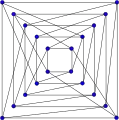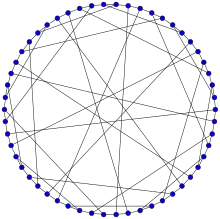Graphe semi-symétrique
En théorie des graphes, un graphe non-orienté est semi-symétrique s'il est arête-transitif et régulier, mais pas sommet-transitif[1]. Autrement dit, un graphe est semi-symétrique s'il est régulier et si son groupe d'automorphismes agit transitivement sur ses arêtes, mais pas sur ses sommets.
| Familles de graphes définies par leurs automorphismes | ||||
|---|---|---|---|---|
| distance-transitif | → | distance-régulier | ← | fortement régulier |
| ↓ | ||||
| symétrique (arc-transitif) | ← | t-transitif, (t ≥ 2) | symétrique gauche (en) | |
| ↓ | ||||
| (si connexe) sommet-transitif et arête-transitif |
→ | régulier et arête-transitif | → | arête-transitif |
| ↓ | ↓ | ↓ | ||
| sommet-transitif | → | régulier | → | (si biparti) birégulier |
| ↑ | ||||
| graphe de Cayley | ← | zéro-symétrique | asymétrique | |
Propriétés
Tout graphe semi-symétrique est biparti[2], et son groupe d'automorphisme agit transitivement sur les deux sous-ensembles de sommets de la bipartition[3].
Il n'existe aucun graphe semi-symétrique d'ordre 2p ou 2p2, où p est un nombre premier[4].
Exemples
Le plus petit graphe semi-symétrique est le graphe de Folkman, qui possède 20 sommets[3].
Tous les graphes cubiques semi-symétriques d'ordre inférieur à 768 sont connus[5]. Le plus petit d'entre eux est le graphe de Gray, qui possède 54 sommets[6].
 Graphe de Folkman, plus petit graphe semi-symétrique, à 20 sommets.
Graphe de Folkman, plus petit graphe semi-symétrique, à 20 sommets. Graphe de Gray, plus petit graphe cubique semi-symétrique, à 54 sommets.
Graphe de Gray, plus petit graphe cubique semi-symétrique, à 54 sommets. Graphe de Ljubljana, graphe cubique semi-symétrique à 112 sommets.
Graphe de Ljubljana, graphe cubique semi-symétrique à 112 sommets. 12-cage de Tutte, graphe cubique semi-symétrique à 126 sommets.
12-cage de Tutte, graphe cubique semi-symétrique à 126 sommets.
Notes et références
- (en) Dragan Marušič et Primož Potočnik, « Semisymmetry of Generalized Folkman Graphs », European Journal of Combinatorics, vol. 22, no 3, , p. 333–349 (ISSN 0195-6698, DOI 10.1006/eujc.2000.0473, lire en ligne, consulté le )
- (en) Norman Biggs, Algebraic Graph Theory, 2d Edition, Cambridge University Press, , 214 p. (ISBN 978-0-521-45897-9, lire en ligne), p. 115-116
- (en) Eric W. Weisstein, « Semisymmetric Graph », sur mathworld.wolfram.com (consulté le )
- (en) Jon Folkman, « Regular line-symmetric graphs », Journal of Combinatorial Theory, vol. 3, no 3, , p. 215–232 (ISSN 0021-9800, DOI 10.1016/S0021-9800(67)80069-3, lire en ligne, consulté le )
- (en) Marston Conder, Aleksander Malnič, Dragan Marušič et Primž Potočnik, « A census of semisymmetric cubic graphs on up to 768 vertices », Journal of Algebraic Combinatorics, vol. 23, no 3, , p. 255–294 (ISSN 1572-9192, DOI 10.1007/s10801-006-7397-3, lire en ligne, consulté le )
- (en) Dragan Marušič, Tomaž Pisanski et Steve Wilson, « The genus of the GRAY graph is 7 », European Journal of Combinatorics, topological Graph Theory and Graph Minors, second issue, vol. 26, no 3, , p. 377–385 (ISSN 0195-6698, DOI 10.1016/j.ejc.2004.01.015, lire en ligne, consulté le )